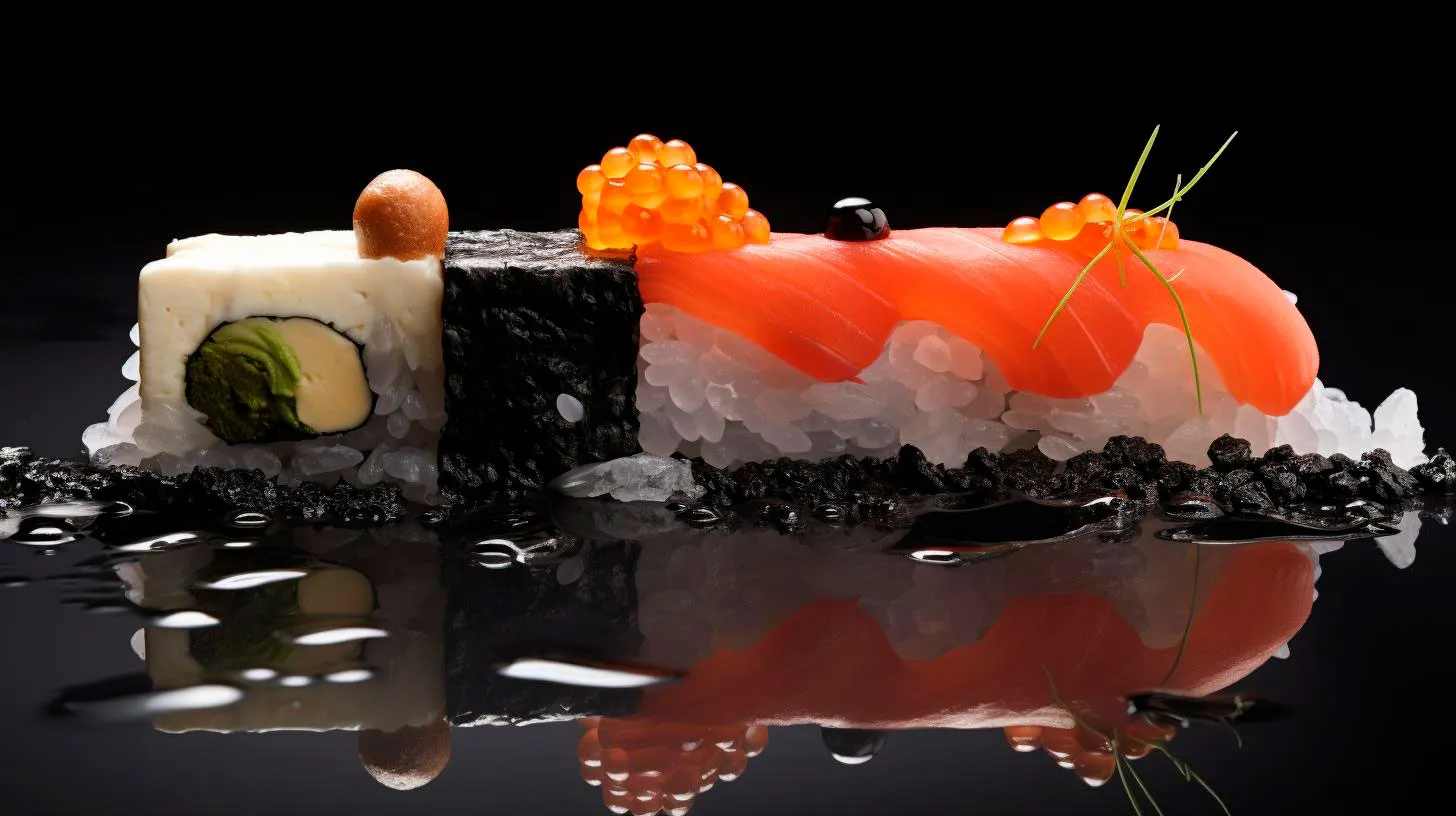From Ocean to Plate: Embracing the Eco-Friendly Side of Sushi Cuisine
Let’s dive deeper into the ocean-friendly initiatives and practices that are transforming the way we enjoy sushi.
The Problem at Hand
Before we explore the solutions, it’s crucial to understand the problem at hand. The growing love for sushi has put immense pressure on our oceans and marine life. Overfishing, destructive fishing methods, and habitat destruction have led to dramatic declines in fish populations worldwide. For instance:
- According to the United Nations Food and Agriculture Organization, approximately 90% of the world’s fisheries are either fully exploited, overexploited, or depleted.
- A study published in the journal Nature revealed that overfishing has caused a 90% decline in large predatory fish populations, such as tuna, swordfish, and marlin, over the past 60 years.
Sustainable Sourcing and Fishing Practices
Fortunately, the sushi industry is taking active steps to combat these challenges and promote sustainability. Here are some key initiatives:
- Responsibly sourced seafood: Many sushi restaurants now prioritize sourcing their seafood from sustainable fisheries or farms that follow stringent environmental standards. This helps reduce the pressure on wild fish populations and ensures the long-term availability of seafood.
- Traceability: To ensure transparency and accountability, some sushi establishments are adopting traceability systems that allow customers to track the journey of their seafood – from the ocean to their plate. This not only promotes sustainability but also fosters trust between the consumer and the restaurant.
- Reduced bycatch: Bycatch refers to the unintentional capture of non-target species during fishing. Sushi restaurants are working towards minimizing bycatch by using selective fishing techniques and equipment that minimize harm to non-target species.
Green Packaging and Waste Reduction
Another significant aspect of sushi’s eco-friendly transformation lies in packaging and waste reduction. Here’s how the industry is tackling this issue:
- Plastic-free packaging: Recognizing the environmental hazards posed by single-use plastics, sushi restaurants are switching to eco-friendly packaging options made from sustainable materials like bamboo, wood, or biodegradable compostable materials.
- Waste management: Restaurants are investing in effective waste management strategies, such as recycling programs and composting, to minimize the amount of waste generated and prevent it from ending up in landfills or oceans.
Impacts and Benefits
The shift towards eco-friendly practices in the sushi industry brings about numerous benefits:
- Preserving biodiversity: By sourcing seafood responsibly, sushi restaurants contribute to the preservation of marine biodiversity and help safeguard fragile ecosystems.
- Protecting fish populations: Implementing sustainable fishing practices aids in replenishing depleted fish stocks, allowing fish populations to recover and ensuring their availability for future generations.
- Enhancing reputation: Embracing eco-friendly practices not only aligns businesses with ethical standards but also attracts environmentally conscious customers. This can lead to increased customer loyalty and positive brand reputation.
- Creating awareness: By promoting sustainability initiatives, the sushi industry plays an important role in educating consumers about the environmental impact of their food choices and inspiring them to make more informed decisions.
The Power of the Consumer
As consumers, we also have the power to contribute to the eco-friendly transformation of the sushi industry. Here are some key takeaways:
- Support sushi restaurants that prioritize sustainable sourcing and environmentally friendly practices.
- Choose sushi made from responsibly sourced seafood.
- Opt for establishments that offer plastic-free packaging options.
- Stay informed about the environmental impact of different sushi ingredients and make conscious choices.
- Encourage restaurants to adopt sustainable practices and promote awareness among your social circles.
By embracing the eco-friendly side of sushi cuisine, we can savor this beloved delicacy guilt-free, knowing that we are contributing to the preservation of our oceans and marine life. Let’s continue championing sustainability and making a positive impact, one sushi roll at a time.
A Sustainable Twist: Exploring the Rise of Green Sushi
In this article, we delve into the concept of green sushi, its advantages, and how it aligns with the growing demand for sustainability.
What is Green Sushi?
Green sushi goes beyond the traditional ingredients by incorporating sustainable practices and eco-friendly alternatives. It focuses on reducing the environmental impact and promoting the well-being of the planet. By adopting green sushi practices, restaurants and sushi lovers alike can contribute to preserving our oceans and marine life.
The Advantages of Green Sushi
1. Ecological Sustainability: Green sushi promotes the use of sustainably sourced ingredients, ensuring the preservation of marine ecosystems. By utilizing responsibly caught fish and seafood, green sushi contributes to the long-term health of our oceans.
2. Reduced Carbon Footprint: Apart from sustainable sourcing, green sushi also prioritizes reducing its carbon footprint. This can be achieved by sourcing local ingredients to minimize transportation emissions and by using energy-efficient practices in sushi preparation.
3. Waste Reduction: Green sushi emphasizes minimizing waste and promoting recycling. Some restaurants even go a step further by adopting compostable packaging materials, reducing plastic waste that often accompanies takeout sushi.
The Key Takeaways
1. Ethical Consumption: Green sushi offers an opportunity for sushi lovers to enjoy their favorite cuisine while making environmentally conscious choices. By supporting sustainability-focused restaurants and demanding responsibly sourced ingredients, consumers can contribute to a more ethical food industry.
2. Environmental Protection: The rise of green sushi highlights the increasing awareness and concern for our planet’s well-being. It serves as a reminder that even small changes in our daily food choices can make a significant positive impact on the environment.
3. Industry Transformation: The growing popularity of green sushi encourages the food industry to adopt more sustainable practices. Restaurants are exploring innovative ways to reduce waste, source responsibly, and educate customers about sustainable food options.
The Rise of Green Sushi
According to various industry statistics:
- The global sushi market is expected to reach $28.6 billion by 2024, indicating a substantial growth opportunity for sustainable sushi options.
- Sustainable seafood sales in the US grew by 3.2% in 2020, showcasing a rising demand for eco-friendly choices.
- Over 90% of consumers are more likely to trust a brand committed to environmental and social issues, reflecting the importance of sustainability in purchasing decisions.
These statistics highlight the potential for green sushi to become a mainstream option in the sushi industry, encouraging more restaurants to adapt their practices and cater to sustainability-conscious consumers.
The Future of Green Sushi
As the demand for sustainable food options continues to increase, green sushi is likely to gain even more popularity. Sustainable sourcing, waste reduction, and environmental responsibility will become essential components of any successful sushi establishment.
With advancements in alternative protein sources, such as plant-based and lab-grown seafood, green sushi can expand its menu options without compromising taste or quality. This will further attract consumers seeking sustainable choices, even if they are not traditional sushi enthusiasts.
The Bottom Line
Green sushi presents a sustainable twist to the traditional sushi experience. By embracing eco-friendly practices, sourcing responsibly, and reducing waste, the sushi industry can contribute to a more sustainable food future. Consumers have the power to drive this transformation by demanding and supporting green sushi. Together, we can make a difference, one delicious roll at a time.
Nutritional Gems: Unlocking the Health Benefits of Veggie Sushi
In this article, we will explore the nutritional gems found in veggie sushi and how they contribute to a wholesome and balanced diet.
Seaweed: A Nutritional Powerhouse
Seaweed, the star ingredient in sushi rolls, offers an array of health benefits. Rich in vitamins, minerals, and antioxidants, seaweed has been consumed for centuries in Asian cultures. Here are some key takeaways on the health benefits of seaweed:
- High in iodine, which supports thyroid function
- Contains essential minerals such as calcium, magnesium, and iron
- Rich in omega-3 fatty acids, promoting heart health
- Packed with antioxidants that protect against cell damage
Additionally, seaweed is a low-calorie and low-fat ingredient, making it suitable for those aiming for weight management and overall well-being.
Vibrant Vegetables: Adding Color to Your Sushi
Vegetables play a crucial role in veggie sushi, providing an explosion of flavors and essential nutrients. By incorporating various colorful vegetables into your sushi, you can enhance its nutritional value. Here are a few nutritional gems found in vegetable sushi:
- Carrots: Rich in beta-carotene, which promotes healthy vision
- Cucumbers: Hydrating and low in calories, contributing to weight loss
- Avocado: Contains healthy fats that aid in nutrient absorption
- Bell Peppers: Excellent source of vitamin C, boosting the immune system
Not only do these vegetables offer numerous health benefits, but they also add delightful textures, flavors, and vibrant colors to your sushi rolls.
Plant-Based Protein: The Heart of Veggie Sushi
While traditional sushi often contains fish or seafood for protein, veggie sushi presents innovative plant-based alternatives. These options serve as a great alternative protein source for both vegetarians and individuals looking to reduce their meat consumption. Some plant-based protein options commonly found in veggie sushi include:
- Tofu: A rich source of protein and essential amino acids
- Edamame: Packed with plant-based protein and fiber
- Tempeh: Provides a meaty texture and high protein content
- Seitan: A wheat-based protein option that mimics the texture of meat
By incorporating these plant-based proteins, veggie sushi becomes a nutritious and satisfying meal choice for individuals following different dietary preferences.
The Importance of Wasabi and Ginger
No sushi experience is complete without the accompaniment of wasabi and ginger. Not only do they enhance the overall taste experience, but they also offer some notable health benefits:
- Wasabi: Known for its spicy kick, it possesses antimicrobial properties
- Ginger: Aids digestion, reduces inflammation, and boosts the immune system
While a little bit of wasabi adds a kick to your sushi, ginger acts as a palate cleanser, allowing you to fully enjoy the flavors of each sushi roll.
Summing It Up
Veggie sushi, with its diverse and nutritious ingredients, offers a multitude of health benefits. From the antioxidant-rich seaweed to the vibrant vegetables and innovative plant-based proteins, every component contributes to a wholesome and balanced diet. Here are some key takeaways:
- Seaweed is rich in iodine, essential minerals, and antioxidants
- Vegetables add color, texture, and essential nutrients to veggie sushi
- Plant-based proteins offer an alternative protein source for vegetarians and meat-reducers
- Wasabi and ginger provide additional health benefits and enhance the overall taste experience
So, the next time you opt for sushi, consider giving veggie sushi a try. Not only will you enjoy a burst of flavors, but you will also be nourishing your body with these nutritional gems.
Gastronomic Delight: Discover the Artistry of Vegetarian Sushi
In this post, we delve into the world of vegetarian sushi and explore its many delights.
The Rise of Vegetarian Sushi
With the increasing focus on healthy and sustainable eating, vegetarianism and plant-based diets have gained immense popularity in recent years. This trend has spilled over into the world of sushi, prompting chefs to unleash their creativity and explore meatless options. By combining a variety of vegetables, fruits, and spices, they have crafted truly remarkable rolls that cater to the growing demand for vegetarian alternatives.
The popularity of vegetarian sushi is not just limited to those following a meat-free diet. It has become a favorite among food enthusiasts and sushi lovers who seek a diverse range of flavors and textures. By offering a break from the traditional ingredients, vegetarian sushi adds an exciting twist for even the most ardent sushi connoisseurs.
Unique Flavors and Combinations
Vegetarian sushi rolls are a playground for chefs looking to experiment with flavors. By using a wide variety of vegetables, fruits, and even herbs, they create a unique blend that takes your taste buds on a journey. Here are some of the delicious and inventive combinations found in vegetarian sushi:
- Tempura Asparagus Roll: Crispy tempura asparagus paired with creamy avocado, tangy mayo, and a sprinkle of black sesame seeds.
- Mango and Cucumber Roll: Sweet and juicy mango combined with refreshing cucumber slices for a tropical twist.
- Shiitake Mushroom Roll: Earthy shiitake mushrooms sautéed in soy sauce and rolled with pickled radish and spring onions.
- Sweet Potato Roll: Baked sweet potato slices topped with spicy mayo and garnished with fresh cilantro leaves.
These are just a few examples of the myriad combinations that vegetarian sushi offers. From the crunch of tempura to the creaminess of avocado, each bite presents a harmonious blend of flavors and textures.
Health Benefits and Sustainability
Vegetarian sushi not only satisfies your taste buds but also offers several health benefits. As opposed to traditional sushi, which often includes calorie-dense fish or seafood, vegetarian sushi focuses on nutrient-rich plant-based ingredients. Benefits of incorporating vegetarian sushi into your diet include:
- Increased fiber intake from vegetables and fruits, aiding digestion and promoting a healthy gut.
- A higher intake of vitamins and minerals found in plant-based ingredients.
- Reduced intake of saturated fat and cholesterol, promoting heart health.
- Supporting sustainable and eco-friendly eating practices by reducing the reliance on seafood and meat sources.
Additionally, vegetarian sushi is an excellent option for those with food allergies or dietary restrictions, as it eliminates the risk of seafood-related allergic reactions.
Key Takeaways
The artistry of vegetarian sushi has taken the world of sushi by storm. Here are some key takeaways to remember about this gastronomic delight:
- Vegetarian sushi offers a diverse range of flavors and combinations, catering to both vegetarians and sushi enthusiasts.
- By experimenting with various vegetables and fruits, chefs create unique and exciting rolls that delight your taste buds.
- Incorporating vegetarian sushi into your diet brings numerous health benefits, including increased fiber intake and reduced saturated fat consumption.
- Choosing vegetarian sushi supports sustainable and eco-friendly eating practices.
So, are you ready to embark on a culinary adventure and discover the artistry of vegetarian sushi? Give your taste buds a treat and experience the diverse flavors and textures that this delightful variation offers.


